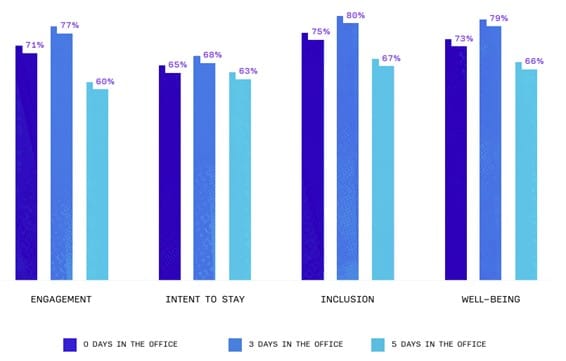Hybrid working has cemented its place as a global standard, with around 80-90% of organisations adopting it.1 Initially a crisis response, flexible work arrangements have become a proactive solution to meet evolving workforce needs. Despite this, some major companies, such as Amazon and Goldman Sachs, are now enforcing a full return to the office (RTO), citing reasons such as business performance and collaboration, though over a quarter of managers lack data to support these claims. This shift is causing friction within teams and prompting career changes. Employees feel that they aren’t trusted – does being in the office and visible to their managers align with work efficiency and performance?
These decisions are dividing teams and causing a wave of new career decisions from employees now used to – and prioritising – hybrid workplaces. Many return to office policies (read mandates) have negatively impacted employee retention -almost a fifth (18%) would consider quitting their job if their employer made hybrid working with majority RTO (3+ days per week) mandatory and those most likely to resign if a strict RTO is mandated are high-performing employees (and, from a demographic perspective, women and millennials).
Many companies are now reviewing and asking themselves – what is the right policy in terms of work location? We’d challenge companies to ask themselves: What arrangements support my employees and teams to be highly engaged and do their best work?
Why do we need to reframe the question in this way?
Gallup’s latest employee engagement research found that companies with high engagement achieved 23% more profit than companies with low engagement. In fact, businesses with 70% of their workforce report that high engagement delivers top-quartile results.2
Recent research from found that the most highly engaged employees work in a hybrid manner, and the lowest engagement came from those working 5 days a week in the office.
If a proliferation of manual processes, confusing architecture and general lack of trust in data sounds familiar, you’re not alone.

Source: Qualtrics, 2024 Employee Experience Trends
So, what arrangements support employees and teams to be highly engaged and do their best work?
There is no one-size-fits-all response to this, nor is there one size for an entire organisation. The answer to this is not simply a question of where individuals work, when and how often, which can be captured in a simple policy.
To support your employees and teams to work effectively, the right working environment and arrangements need to address how they work, not just where. We recommend taking an organisational design approach and reimagining how work is done to enable high engagement, productivity, connection and enjoyment.
1. Reimagine work design
Involve teams in reviewing how effectively they work – identify what is working well and where the challenges lie given remote and hybrid working arrangements. Design to address the key challenges and key ‘moments that matter’, e.g. team meetings and brainstorming sessions. Ask teams to think about what is more effectively done in the office versus remotely. This will give them a sense of ownership, understanding and alignment on what will work for them as an overall team (and the other teams they interact with), not simply as individuals. This should drive your organisation forward to improved working methods, rather than regressing to previous styles.
2. Foster contemporary performance management and leadership practices
Many employees feel that the mandate for return to office is more about trust than performance. This is an opportunity to revisit and strengthen performance measures – what are individuals and teams delivering? The role and skills of managers, therefore, also need to be reviewed. If they are moving from day-to-day task management to team building and team development, you need to look at the skills and behaviours for leaders to succeed in this new environment.
To maintain an engaged, agile and productive workforce, leaders should focus on inclusion, collaboration, digital dexterity, coaching and leading through change. The good news is that these are all teachable practices! Smart investments in leadership training must be balanced (and integrated) with shifts in how leaders are incentivised, promoted and supported.
3. Invest in technology to enable great work
It’s an organisation’s responsibility to support their people to deliver great work. As teams redefine how they can work most effectively, providing them with a great experience and delivering business requirements, they will undoubtedly require technology to support them. How can technology make asynchronous and remote collaboration more effective? Can AI and new technology take away some of the ‘graft’? Strategic investments in digital solutions to support employee experience and maximise hybrid and virtual productivity are critical. Technology and talent leaders must work collaboratively to identify and prioritise these investments.
BE BOLD
Hybrid working provides the opportunity to reimagine how work is done, evolve leadership practices and provide the case for strategic technical investment. Instead of looking backwards and reverting to old norms, actively engage with your employees to reimagine how they work effectively – individually, as a team and as an organisation. This will yield the best results for all.
1 Management Today, The New Normal, 13 June 2024
2 Gallup, State of the Global Workplace, 2024 Report
Follow us on LinkedIn to stay up to date with our latest insights
Our team are passionate about helping organisations actively engage with their employees to reimagine how they work effectively.


